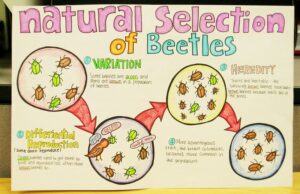5 Genetics and Evolution
5.1 Hereditary and Variation
Heredity and variation
Dr V Malathi
Heredity
The process by which characteristics are transferred from parents to children is known as heredity. Genes, which are sections of DNA found on chromosomes. Genes are the means by which this transmission of traits takes place. Each gene can exist in different forms called alleles, which contribute to the diversity of traits observed in a population.
Heredity explains why you may have the smile or eyes of your father. DNA, which carries the instructions needed to create and maintain an organism, is the medium via which this genetic information is transferred. Gregor Mendel initially proposed the theory of Mendelian inheritance, which describes how dominant and recessive alleles cause features to be inherited in predictable ways. However, heredity is more than just what you inherit—it’s essential to evolution. Natural selection is fueled by the interaction of genetic variety and inherited qualities, which accounts for the diversity of life on Earth.
Fundamentally, heredity is the process that maintains the genetic heritage of life and ties generations together.

Variation
The differences in characteristics between members of a population are referred to as variation. Variation may arise due to environmental or genetic cause.
Sources of Genetic Variation:
- Mutations: Changes in the DNA sequence that can introduce new genetic variations. Essentially, mutations are the building blocks of evolution. Mutations can result from errors in DNA replication. These can be brought on by a number of things, including external effects like radiation or specific substances, or they can even happen on their own. The majority of mutations are either detrimental or neutral, however on rare occasions, they can confer a positive characteristic that aids in reproduction for an organism. Here’s when genetic diversity becomes relevant. The ability of a population to adapt to changing conditions depends heavily on genetic variation. A single alteration in the surroundings may lead to the extinction of the entire population if all people shared the same genetic makeup. New alleles brought about by mutations can be switched around during reproduction to provide a varied gene pool. After that, natural selection affects this variance, favoring advantageous mutations and removing the detrimental ones over many generations. This process allows populations to evolve, adapt, and thrive in their specific environments.
- For further reading about Mutation , visit the chapter on Mutations and Variation from Crop Genetics
- Genetic recombination : The genetic rearranging that occurs during sexual reproduction is basically known as genetic recombination. Homologous chromosomes exchange DNA fragments during meiosis, the process that creates gametes (sperm and egg cells). The genes from each parent are mixed together during this process, which is known as crossing over. What was the outcome? A distinct genetic makeup is present in every gamete. Genetic diversity within a population is increased by this recombination, which guarantees that kids have a distinct gene combination than either parent. Similar to nature’s insurance policy is genetic variety. Populations can resist diseases, prevent genetic abnormalities, and adapt to changing environments by developing a wide range of genetic features. It explains why siblings who have the same parents can still appear and behave so differently from one another.
- Gene Flow : Gene flow, sometimes referred to as gene migration, is the transfer of genetic material across distinct populations. Consider it as nature’s method of blending the genetic ingredients. New genetic material is added to the gene pool when individuals from distinct populations interbreed and have offspring that contain a combination of genes from both populations. A population’s genetic variety can be greatly increased by this introduction of new genes. Gene flow has the power to disperse beneficial features more broadly and keep populations from diverging genetically, both of which are essential for a species’ survival and adaptability
Types of Variation:
- Continuous Variation: The term “continuous variation” describes the variety of minute variations that we observe in a common feature among members of the same species. Consider the range of human heights—not just the tall and the small, but also all points in between. This category includes characteristics like IQ, skin tone, and weight. Environmental variables can also shape these variances, which are often impacted by numerous genes (polygenic inheritance). Instead of discrete classifications, the outcome is a continuous gradient of phenotypes. It’s similar to combining paints to achieve the ideal shade as opposed to selecting from a limited palette.
It’s what makes each person uniquely themselves! - Discontinuous Variation: Characteristics classified into discrete groups as opposed to a continuous range are referred to as discontinuous variation. Consider your blood type: there are no intermediate types; you are either type A, B, AB, or O. This type of variation is less affected by the environment and is often regulated by one or a small number of genes.
The capacity to roll your tongue, the color of a plant’s bloom, and the existence or absence of specific inherited conditions are a few examples of discontinuous variation. It’s how nature decides on some characteristics in black and white while leaving others open to interpretation.
Video Links for further understanding

